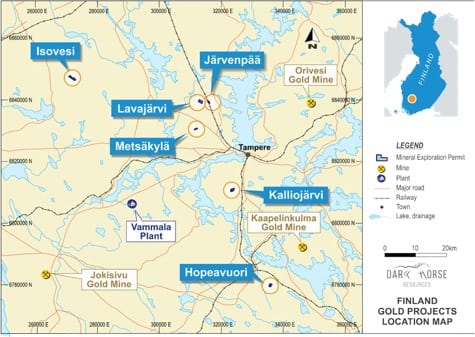Drilling To Be Carried Out On Advanced Hopeavuori Permits
Dark Horse Resources Ltd (ASX:DHR) is preparing to conduct its first drilling programme at the Tampere Gold Project in Finland. Commencement of drilling is planned to begin as soon as feasible during the final calendar quarter of 2020.
The Permit Purchase Agreement (PPA) was recently executed between Sotkamo Silver AB and DHR, for 100% of the interest in a number of highly prospective Gold exploration permits in Finland, known as the Tampere Gold Project. These permits are currently being transferred to one of DHR’s Finnish subsidiary companies, but completion of this regulatory process may take several months.
DHR raised approximately A$2 million cash in July and August 2020 and has is currently raising a further $343,000 (before costs) which will comfortably cover the company’s plans for Gold exploration drilling in Finland and Argentina.
Dark Horse’s objectives are to advance the Finland Tampere Gold Project towards defining JORC Resources within the next twelve months. The DHR technical team have been compiling and evaluating all historic geological data during the past months and designed a comprehensive and systematic exploration programme.
Drilling will be carried out on the most advanced Hopeavuori permits, with some drilling also at Kalliojärvi and Metsäkylä. The drilling programme will target the known thick, high-grade Gold mineralised structures defined by Sotkamo and prior workers.
It will comprise of several thousand metres of diamond drilling initially in the known mineralised areas, and then will follow the structures along strike to test their extent.
Negotiations are underway to engage a local well respected, and experienced drilling company, as is permitting, logistical planning and developing a technical team to supervise the work.
Drilling at Hopeavuori Main will be undertaken to test the presence and continuity of high-grade mineralisation within the two main interpreted north-south trending structures.
Diamond drilling will be utilised to enable core orientation and structural analysis to be undertaken for input into the current mineralisation model. Two high-grade historical drill holes will be twinned to compare mineralisation and analysis methods. The first phase of drilling will comprise 10 holes for 1,070 metres. Holes will be drilled east at between 40-45 degrees which is considered optimal for targeting the steeply dipping high-grade mineralisation. Holes range between 50m and 100m depth to infill between existing drillholes as well as targeting strike and depth extensions. Holes will be drilled in order of priority and adjustments may be made as structural information becomes available.












